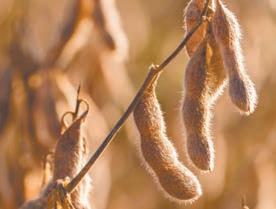Ag Matters


Fall 2023
INSIDE
•How labor shortages are affecting agriculture
•The basics of regenerative agriculture

•The link between agriculture and food security and more... est











































•How labor shortages are affecting agriculture
•The basics of regenerative agriculture

•The link between agriculture and food security and more... est









































Consumer demand drives changes in industry, and the agricultural sector is no exception. Consumer demands for improved animal welfare have led to changes in the livestock sector, and various technologies have been developed and are in development to help this particular segment of the agricultural industry thrive.
According to the Animal AgTech Innovation Summit, various startups have developed technologies that can make the livestock industry more sustainable and efficient.

The Israeli firm Armenta has developed a non-antibiotic treatment for bovine mastitis that utilizes acoustic pulse technology. The treatment has a 70 percent cure rate.

Another firm working to treat livestock is the United States-based General Probiotics. Animal AgTech reports that General Probiotics develops cellbots and antimicrobial probiotics that eliminate harmful pathogens in livestock. That can reduce dependency on antibiotics and make food production safer.

Faromatics, a firm based in Spain,




has combined robotics, artificial intelligence and big data to improve animal welfare and farm productivity. One Faromatics product utilizes a




robot suspended from a ceiling to monitor certain variables, including equipment function and health and welfare, that affect broiler chickens.
The American firm Swinetech utilizes voice recognition and computer vision technology in its SmartGuard product to prevent piglet deaths from crushing and starvation. The product also makes it possible to track and facilitate obstetrical assistance.
Based in Uganda, Jaguza Tech has developed a livestock management system that utilizes sensors, data science and machine learning to improve the efficiency, productivity and sustainability of modern farm operations. Farmers can utilize Jaguza to perform a host of functions, including monitoring their animals’ health and identifying their livestock.
The Netherlands-based H2Oalert is a water control management system that checks the quality and quantity of cattle drinking water in real time. The management system also checks for pollution and malfunctions in the water supply.
Livestock technology continues to advance, and firms across the globe are developing new products and platforms to help livestock farmers make their operations more efficient, sustainable and productive.
AG223782
Sustainable agriculture is an approach to farming that will allow modern farmers to meet the needs of a growing population while enhancing environmental quality. That can benefit both current and future generations, and technology will play a vital role in realizing the goals of sustainable agriculture.
According to the National Sustainable Agriculture Coalition, sustainable agriculture is designed to meet the needs of the present without compromising future generations’ ability to meet their own needs. That’s a worthy goal, especially in the face of a growing global population that the United Nations estimates will increase by two billion persons by 2050.
There are numerous benefits to utilizing sustainable agriculture technology, which can be especially advantageous to modern farmers.
Modeling technologies can be utilized to make more efficient use of land. According to Sustainable Brands, a global community of brand innovators, modeling technologies can be employed in a host of ways, including to identify tillage practices and the status of tile drainage. Certain agricultural technologies have been designed to predict the performance of cropland, which can allow
farmers to more effectively and efficiently use their land. Farmers also can employ modeling technologies to determine soil health and water needs and usage, which can benefit the land and ensure resources aren’t wasted. Utilization of such technologies ensures farmers can meet the needs of modern consumers without affecting future farmers’ ability to do the same.
The United States Environmental
Protection Agency notes that runoff poses a significant threat to the environment. When runoff occurs, fertilizer, bacteria and other pollutants find their way into streams, rivers, lakes, and the ocean. Sustainable Brands notes that nanotechnology is an efficient way to deliver nutrients to crops that can improve both the efficacy of the nutrients and reduce runoff.


Sustainable Brands notes that agri-









cultural biologicals are inputs derived from natural materials that have low toxicity. That low toxicity reduces their environmental impact. Agricultural biologicals utilize the properties of such things as bacteria, fungi and even insects to support healthy crops, potentially improving yield without adversely affecting the environment. Sustainable agriculture technologies can help modern farmers and their successors meet the needs of a rapidly growing global population.
AG223783















The agricultural workforce is shrinking, and has been for some time. The American Farm Bureau Federation estimates there are roughly 2.4 million farm jobs that need to be filled annually, but there has been a drastic decline in workers each year.
There are a number of reasons for the shortages. The AFBF says more than 73 percent of farm workers are immigrants from South America and Mexico. While the United States’ H2-A visa program, which allows employers who meet specific requirements to bring foreign laborers in for temporary work, has increased the number of accepted applications for immigrants to 250,000, this number is still just a drop in the bucket in terms of labor needs.
Another factor is a career in agriculture isn’t always easy or lucrative. According to the U.S Department of Agriculture, for every dollar spent on food, a farmer receives only 7.6 cents. Farmers were predicted to lose 9.7 percent of total net income in 2021. Declining interest in the field has also affected the number of farm workers. As more farm operators reach retirement age, fewer young farmers are replacing them due to volatile pricing, high real estate and

land costs, steep initial machinery investment costs, and other factors. The physical demand of the industry also takes its toll. So what does this mean for the agricultural industry?


Many with knowledge of the industry indicate sweeping changes are warranted. Ellen Poeschi, the project director for the National Association of Agricultural Educators Teach Ag campaign, has said that a lack of agricultural education is contributing to the problem. Increasing availability of ag education courses across the country could build interest in the industry. Connecting students to intern-
ships or mentors may help, too.
Another option is to rally for greater economic opportunities in agriculture. The ag industry in general needs to find ways to make the economic benefits more competitive to other industries, and improve the working conditions and job flexibility. Agricultural industries currently average only 60 percent of what other industries offer in salaries. Farm wages have been rising due to the H-2A program, which requires farm worker pay to be higher than the state/federal minimum wage. More change is needed, but this may have to come at the federal level
or be sparked by efforts on the part of agricultural advocacy groups.



Additional strategies farm operators can employ to combat shortages are: scaling back farm operations; integrating ag technology to reduce labor burdens; pivoting to crops that require fewer laborers; leasing portions of land to have extra money; employing temporary guest workers; and moving operations abroad.
Worker shortages continue to be problematic for the agricultural industry. A greater focus on remedying the issue is needed on a grand scale.
AG233740










Climate change poses a threat to various industries, not the least of which is the agricultural sector. Agricultural industry insiders recognize that the changing climate has been forcing farmers and agricultural organizations to adapt and adjust for decades, and that need to be flexible won’t change in the years to come.




One of the changes many farmers may consider in coming years, if they haven’t already, is a pivot to regenerative agriculture practices. Regenerative agriculture could have a profound impact on the world over the next half century, so now may be a great time to gain an understanding of the practice.
Regenerative agriculture is a production system that focuses on reducing water usage and other inputs as part of a larger attempt to prevent land degradation and deforestation. According to the organization Green America®, regenerative agriculture is designed to harness the power of photosynthesis in plants to sequester carbon in the soil. The ability to do that can improve soil health, crop yields, water resilience, and nutrient density.
GreenAmerica® notes that regenerative agriculture draws down atmospheric carbon dioxide. That’s a significant benefit, as Climate.gov, which is a product of various depart-


ments within the National Ocean and Atmospheric Administration, reports that adding more carbon dioxide to the environment is causing global temperatures to rise. In fact, observations from the NOAA Global Monitoring Lab in 2021 revealed that
carbon dioxide alone was responsible for about two-thirds of the total heating influence of all human-produced greenhouse gases. GreenAmerica® reports that, at scale, regenerative agriculture could help to reverse the climate crisis by drawing down atmospheric carbon dioxide.
Another reason to consider regenerative agriculture is its connection to topsoil. GreenAmerica® reports that the world is on the cusp of running out of topsoil, which is vital to growing food. Regenerative agriculture rebuilds topsoil, which can lead to greater food security across the globe.

Regenerative agriculture practices include the usage of cover crops, a reduction in tilling, crop rotation, and spreading compost. GreenAmerica® notes that regenerative agriculture practitioners also avoid the use of synthetic fertilizers, pesticides, herbicides, and factory farming.
As the climate crisis continues to challenge the agricultural sector, regenerative agriculture could help farmers and the larger industry successfully confront those issues. AG233749

Plants often are only as strong as the soil in which they grow. While certain greenery may thrive no matter where it’s planted, soil conditions are often key to successful growing. Sodic soil is one condition people may experience at home or in commercial farming operations. Sodic soils, sometimes called saline-alkali soils or dispersive soils, are defined as having high levels of exchangeable sodium and low levels of total salts, according to the Colorado State University Extension. These conditions compromise growing conditions because sodic soils tend to be poorly drained and crust over. Water intake also can be poor in sodic soils, and pH is usually high — coming in above 9.0.


The Department of Primary Industries and Regional Development of the Government of Western Australia advises a simple sodic soil test to check for sodicity. One can collect dry soil aggregates (crumbs of soil) from different depths. Those crumbs should be placed into a clear jar of distilled water, taking care not to mix or agitate the soil. The water around the edges of sodic soil will become cloudy and appear
milky. For highly dispersive soil, the dispersion will be evident after about 10 to 30 minutes. Moderately sodic soil may take 2 hours.

Individuals can take steps to improve sodic soil. Gypsum is the most commonly used amendment for sodic soil, according to Science Direct. It also can reduce the harmful effects of high-sodium irrigation waters. Gypsum is a mineral that is composed of hydrated calcium sulfate. Gypsum has an effect on reducing the rate of soil erosion. It is more effective when gypsum is spread on the soil surface rather than mixed in.
Limestone, which also contains calcium, is another additive that can amend sodic soils. Gardeners may want to add calcium to the soil because it replaces the sodium and then the sodium can be leached out.

Additional mitigation methods for sodic soils include changing plant species or varieties to more tolerant ones that will grow more readily.
Commercial farmers or home gardeners may encounter sodic soil. Though sodic soil is not ideal, it can be remedied in various ways.
AG233755

Farmers have been pressured to increase production to meet the demand of a growing population. This may require employing more efficient measures to ensure maximum output. Unfortunately, efficiency doesn’t always mesh with sustainability, so commercial operations have had to make some modifications to find a balance between serving the public and protecting the planet.
Green farming utilizes different technology and practices in order to decrease detrimental impact on the environment. According to the farming resource NuFarming, agricultural operations have a significant impact on climate change. Simply adopting some new practices can lessen that impact.

Growing plants are not the only thing on a farm that can benefit from the sun. Farmers can convert a portion or all of their power needs to solar. According to the U.S. Department of Energy, there are benefits when solar companies and farmers work together. Solar developers reduce installation costs and upfront risk by placing solar modules on
previously tilled agricultural land. Vegetation under modules also can contribute to lower soil temperatures and increased solar performance. Agricultural land managers can reduce energy costs and diversify their revenue streams with solar. Plus, they can market products to sustainability-minded customers.

Solar is not the only renewable energy option. Farmers can incorporate wind and hydroelectric power as well.
This farming technique has been used for thousands of years and involves growing different crops in different seasons over a period of time. Farmers reduce the chances for pests and diseases becoming problems in the soil because frequent crop changes prevent invaders from gaining a foothold. Farmers use fewer fertilizers and pesticides as a result.
Farmers can improve productivity while also reducing environmental impact with these two growing methods. NuEnergy states that hydroponic systems grow plants in mineral solutions or in materials like perlite or gravel. Aquaponics involves raising aquatic animals in addition to growing crops. The waste from the fish and other marine life is used to offer nutrients to the plants by growing them in this nutrient-rich water. Both methods remove the need for soil.
Drip irrigation methods deliver water to the roots of plants through a series of pipes or tubes. Because

water is not being sprayed into the air through sprinklers and other methods, less is lost to evaporation, and less water overall may be needed to provide for crops.
Plastic seems like it may not have a purpose on the farm, but recycled plastic, which is used in plastic mulch, can help produce plentiful crops with less water. Plastic mulches raise soil temperatures and insulate against evaporation so plants can grow faster and mature sooner. Invasive weeds also may be less likely to take root in plastic mulch or when crops are grown on black plastic.


Farmers can introduce plants that pests tend not to like to reduce reliance on chemical pesticides. For example, interspersing crops with natural bug repellants, such as basil, lavender and lemongrass, may keep insects at bay. Alliums, chrysanthemums, marigolds, and other flowers planted nearby also may deter bugs. Green farming is something more agricultural operations may want to adopt. AG233756


The world faces many unique challenges in the decades to come, including a rapidly expanding global population. The United Nations estimates that the global population will reach 9.71 billion in 2050. That’s an increase of more than 1.7 billion people between 2023 and 2050.
Food security is among the more significant challenges the world will face as the population increases. The United States Agency for International Development notes that food security means all individuals, regardless of their physical or economic circumstances, have access to sufficient food to meet the dietary needs for a productive, healthy life. Food security is a more significant issue than people may recognize, even in first world, fully developed countries. For example, the United States Department of Agriculture’s Economic Research Service indicates that slightly more than 10 percent of U.S. households were food insecure at some point during 2021. In fact, estimates suggest more than 800 million people across the globe go to bed hungry every night, which underscores the seriousness of the issue.


Food security and the agricultural industry are inextricably linked. The USAID indicates that most of the people who go to bed hungry at night are smallholder farmers who depend on agriculture to make a living and feed themselves and their families. Supporting efforts to strengthen the agricultural industry can help to
combat food security, as the USAID reports that growth within that sector has been found to be at least twice as effective at reducing poverty as growth in other sectors. Much of that can be traced to the disproportionate percentage of poor people who live in rural rather than urban areas. For example, the USAID reports that 75 percent of poor people in developing
nations live in rural areas.
But the poverty rate is higher in rural areas than urban areas in the United States as well. Data from the 2019 American Community Survey indicates the poverty rate in rural areas was 15.4 percent in 2019 compared to 11.9 percent in urban areas. Though recent data regarding rural poverty rates in Canada is unavailable, a 2013 discussion paper on the topic from the Government of Canada noted that the country’s rural residents earned less and had lower levels of education than residents in urban areas, suggesting that poverty is likely more prevalent in the Canadian countryside than in the country’s cities.

Though food security poses a significant global challenge, lack of access to healthy foods is preventable. Individuals in rural and urban communities can voice their support for efforts to strengthen the agricultural sector. A thriving agricultural sector can ensure fewer people go to bed hungry each night and bolster the economies of rural communities that are disproportionately affected by poverty. AG233757







